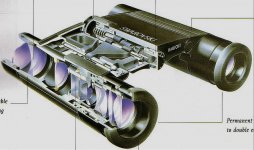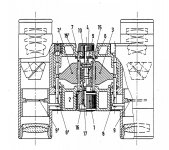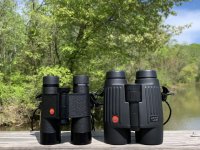henry link
Well-known member
Hi John,
Thanks for posting the cutaways. I tend to forget about the compacts, so I hadn't even noticed the high transmission. It must be at least partly due to the relative simplicity. The only other contributing factor would seem to be a shorter light path through the glass of the tiny prisms and thin lenses.
Looking just now at a cutaway of an old Swarovski compact from a 1999 catalogue I see it has a more complex design than the Leica, with a 5 element (2-1-2) eyepiece and a glass cover plate in front of a 2 element (1-1) objective, giving a total of 16 surfaces (including 4 from the prisms) compared to 12 for the Leica (including prisms).
In Gijs' 2005 tests I can't see the Swarovski's 4 extra surfaces accounting for more than a 1-2% difference in transmission and the length of the light path through glass would have been about the same. Perhaps in 2005 Leica was also using better AR coatings and higher reflectivity mirror coating in their compacts than Swarovski or Zeiss.
Henry
Thanks for posting the cutaways. I tend to forget about the compacts, so I hadn't even noticed the high transmission. It must be at least partly due to the relative simplicity. The only other contributing factor would seem to be a shorter light path through the glass of the tiny prisms and thin lenses.
Looking just now at a cutaway of an old Swarovski compact from a 1999 catalogue I see it has a more complex design than the Leica, with a 5 element (2-1-2) eyepiece and a glass cover plate in front of a 2 element (1-1) objective, giving a total of 16 surfaces (including 4 from the prisms) compared to 12 for the Leica (including prisms).
In Gijs' 2005 tests I can't see the Swarovski's 4 extra surfaces accounting for more than a 1-2% difference in transmission and the length of the light path through glass would have been about the same. Perhaps in 2005 Leica was also using better AR coatings and higher reflectivity mirror coating in their compacts than Swarovski or Zeiss.
Henry








